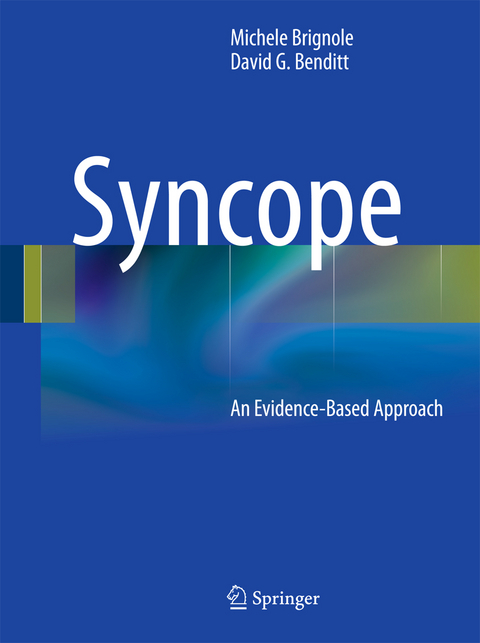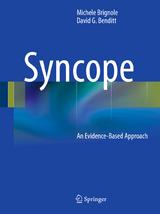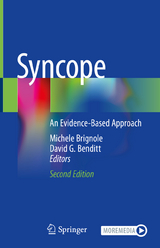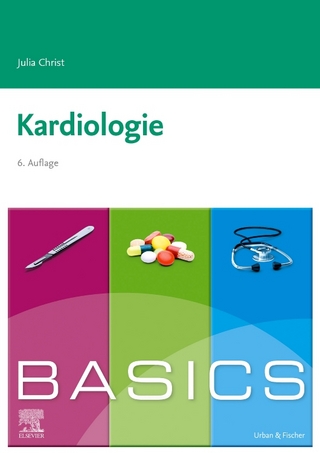Syncope
Springer London Ltd (Verlag)
978-0-85729-200-1 (ISBN)
The Editors of this book present a thorough multidisciplinary review of the topic. Guideline-based, they have assembled a team of key opinion leaders in the study and management of syncope.
The first section of the book discusses the scientific basis behind the diagnosis and management of syncope going into detail regarding the pathways leading to syncope symptoms and the pathology behind them.
The second section of the book then takes a more practical approach defining the practice of syncope management and including a number of case histories explaining the pearls and pitfalls of the current guidelines.
SECTION ONE A – Current evidence-based knowledge: Classification, Pathophysiology and Social / Economic Impact.- Chapter 1. Syncope: definition, terminology, and classification.- 1.1 Definition.- 1.1.1 Loss of consciousness.- 1.1.2 Onset is relatively rapid.- 1.1.3. Recovery is spontaneous, complete and usually prompt.- 1.1.4. Underlying mechanism is transient global cerebral hypoperfusion.- 1.2. Terminology.- 1.3. Classification.- 1.3.1 Neurally-Mediated Reflex Syncope.- 1.3.2 Orthostatic (Postural) Syncope.- 1.3.3 Cardiac (Cardiovascular) Syncope.- 1.4. Conclusion.- Chapter 2. Pathophysiology of syncope.- 2.1 Maintenance of Adequate Cerebral Blood Flow.- 2.1.1 Autonomic Neural Control.- 2.1.2 Cerebrovascular Autoregulation.- 2.2 Failure to Maintain Cerebrovascular Perfusion.- 2.2.1 Neurally-mediated cerebral hypoperfusion.- 2.2.2 Non-neurally-mediated causes of hypotension.- 2.3 Clinical perspectives.- Chapter 3. Epidemiology of syncope (fainting).- 3.1 Prevalence and Incidence.- 3.1.1 Community-based estimates.- 3.1.2 Selected population estimates.- 3.2 Syncope recurrences.- 3.3 Mortality Concerns.- 3.4 Unresolved Prognostic Issues.- 3.5 Clinical Perspectives.- Chapter 4 Syncope burden: economic impact of syncope on healthcare resources and personal well-being.- 4.1 Cost of TLOC/Syncope Care.- 4.1.1 Current Status.- 4.1.2 Opportunity for Reducing Cost.- 4.2 Quality of life.- 4.3 Clinical perspectives.- SECTION ONE B – Current evidence-based knowledge: Structured Diagnostic Strategy.- Chapter 5. The initial evaluation of T-LOC: diagnostic strategy based on the initial findings.- 5.1 The Initial evaluation.- 5.1.1 History and physical examination.- 5.1.2 Baseline electrocardiogram.- 5.1.3 Additional tests.- 5.2 The 3 main question to be addressed at initial evaluation.- 5.2.1 Is loss of consciousness attributable to syncope or not?.- 5.2.2. Is heart disease present or absent?.- 5.2.3. Is there features in the history that suggest the diagnosis?.- 5.3 Thediagnostic strategy based on the initial evaluation.- 5.3.1 Certain diagnosis.- 5.3.2 Uncertain diagnosis.- 5.4 Diagnostic yield of the initial evaluation.- 5.5 Clinical perspectives.- Chapter 6. T-LOC Risk stratification.- 6.1 Introduction.- 6.2 Assessing the risk.- 6.2.1 Risk of death and life-threatening events.- 6.2.2 Risk of syncope recurrence.- 6.3 Management according to risk stratification.- 6.4 Clinical perspectives: in-hospital versus out-patient evaluation in specialized facilities.- Chapter 7. Indications for and interpretation of laboratory diagnostic tests.- 7.1 Introduction.- 7.2 Carotid sinus massage.- 7.2.1 Indications.- 7.2.2 Interpretation of results.- 7.3 Orthostatic challenge (Active Standing Test and Tilt-table Testing).- 7.3.1 Active Standing Test.- 7.3.2 Tilt-table testing.- 7.4 ATP (Adenosine) test.- 7.4.1 Indications.- 7.4.2 Interpretation of results.- 7.5 Electrophysiological study.- 7.5.1 Suspected sinus node disease (SND).- 7.5.2 Bundle Branch Block.- 7.5.3 Suspected supraventricular tachycardia.- 7.5.4 Suspected ventricular tachycardia.- 7.5.5 Indications.- 7.5.6 Interpretation of results.- 7.6.1 Indications.- 7.6.2 Interpretation of results.- 7.7 Other tests.- 7.8 Diagnostic yield of laboratory tests in patients with uncertain syncope.- 7.9 Clinical perspectives.- Chapter 8. Prolonged Ambulatory ECG diagnostic monitoring ...current and evolving indications.- 8.1 Introduction.- 8.2 Interpretation of results.- 8.3 In-hospital monitoring.- 8.3.1 Indications.- 8.4 Holter monitoring.- 8.5 External loop recorder (ELR) and remote at-home telemetry.- 8.5.1 Indications.- 8.6 Implantable loop recorder (ILR).- 8.6.1 Natural history of syncope (probability of recurrence of syncope) in patients at low risk.- 8.6.2 Value of ILR in diagnosis of syncope.- 8.6.3 ILR in syncope – where in the workup?.- 8.6.4 Indications.- 8.6.5 Classification of responses.- 8.5.7 Therapy guided by ILR.- 8.5.8 Technical aspects.- 8.6 Diagnostic yield of prolongeddiagnostic monitoring in patients with uncertain syncope.- 8.7 Clinical perspectives.- Chapter 9. Syncope facilities: background and current standard.- 9.1 Background: why should we need a dedicated facility?.- 9.2 Some existing syncope facility models.- 9.2.1 Newcastle.- 9.2.2 Manchester.- 9.2.3 Controlled studies of patients presenting with syncope to the Emergency Department.- 9.3 The standards recommended by the ESC guidelines.- 9.3.1. Referral.- 9.3.2. Objectives.- 9.3.3. Professional skill mix for the Syncope Unit.- 9.3.4. Equipment.- 9.4 Clinical perspectives.- Chp 10.- Syncope (T-LOC) Management Units: the Italian model.- 10.1 Introduction.- 10.2 The Italian Syncope Management Unit.- 10.2.1 Clinical results.- 10.2.2 Volume of activity.- 10.2.3 Referral.- 10.2.4 Diagnosis.- 10.2.5 Treatment.- 10.2.6 Hospitalization and cost analysis.- 10.3 Clinical perspectives.- SECTION ONE C – Current evidence-based knowledge: Clinical Syndromes - Diagnosis and Therapy.- Chapter 11. Reflex syncope (neurally-mediated syncope) 11.1 The wide clinical spectrum of an unique disorder 11.2 Diagnosis 11.3 Identifying the etiology of syncope 11.3.1 Vasovagal syncope 11.3.2 Situational syncope 11.3.3 Carotid sinus syncope 11.3.4 Atypical forms 11.3.5 Likely reflex (neurally-mediated) 11.4 Identifying the mechanism of syncope 11.4.1 ECG monitoring 11.4.2 Carotid sinus massage. 11.4.4 ATP (adenosine triphosphate) tests. 11.5 Therapy 11.5.1 Lifestyle measures 11.5.2 Additional treatments 11.5.3 Physical counterpressure maneuvers (PCM) 11.5.4 Tilt Training (Standing training) Method 11.5.5 Pharmacological Therapy 11.5.6 Cardiac Pacing 11.5.7 Conclusion 11.6 Clinical perspectives Chapter 12. Orthostatic Intolerance: Orthostatic Hypotension and Postural Orthostatic Tachycardia Syndrome 12.1 Introduction 12.2 Terminology 12.2.1 Orthostatic intolerance 12.2.2 Orthostatic hypotension (OH) 12.2.3 Postural Orthostatic Tachycardia Syndrome (POTS) 12.2.4 Dysautonomia 12.3 Physiology of BloodPressure Control 12.4 Failure To Maintain Blood Pressure 12.5 Clinical Conditions 12.5.1 Orthostatic Syncope and Near-Syncope 12.5.2. Postural tachycardia syndrome (POTS) 12.6 Treatment of Orthostatic Intolerance 12.6.1 General measures 12.6.2 Non-pharmacological treatment strategies 12.6.3 Pharmacological treatment 12.7 Clinical perspectives Chapter 13. Cardiac Syncope 13.1 Introduction 13.2 Prognosis 13.3 Identifying a 'Cardiac origin' 13.4 Cardiac Conduction System Disease and Arrhythmias 13.4.1 Sinus node dysfunction (SND). 13.4.2 Atrioventricular conduction disorders 13.4.2 Supraventricular tachyarrhythmias 13.4.3 Ventricular tachycardias 13.5 Structural Cardiopulmonary Diseases 13.5.1 Myocardial Ischemia 13.5.2 Outflow Tract Obstruction 13.5.3 Other cardiopulmonary conditions that may cause syncope 13.6 Diagnostic Strategies 13.6.1 Evaluation In or Out of Hospital? 13.6.2 Specific Testing 13.7 Treatment 13.7.1 Addressing underlying structural disease as the treatment of syncope 13.7.2 Addressing underlying structural disease is not feasible or adequate 13.8 Clinical perspectives Chapter 14 Conditions that mimic syncope 14.1 Introduction 14.2 Syncope-Mimics and Pseudosyncope 14.3 Non-Syncope T-LOC 14.3.1 Epilepsy 14.3.2 Concussion 14.3.3 Metabolic and endocrine conditions mimicking syncope 14.4 Syncope / TLOC Mimic 14.4.1 Somatization Disorders (Pseudosyncope, 'Pseudoseizures') 14.4.2 Cataplexy 14.4.3 Hyperventilation 14.4.3 Transient ischemic attacks 14.5 Clinical perspectives Chapter 15. Unexplained syncope in patients with high risk of sudden cardiac death 15.1 Introduction 15.2 Ischaemic and non-ischaemic cardiomyopathies 15.2.1 Pre-existing established indications for ICD therapy 15.2.1 Not pre-existing established indications to ICD 15.3 Hypertrophic cardiomyopathy 15.4 Arrhythmogenic right ventricular cardiomyopathy/dysplasia 15.5 Primary electrical diseases 15.5.1 Long QT syndrome 15.5.2 Brugada syndrome 15.5.3 Catecholaminergic polymorphic ventriculartachycardia 15.5.4 Short QT syndrome 15.6 Clinical perspectives: the role of ICD SECTION TWO– Syncope management in clinical practice: How to Do It Chapter 16. How to. Role of Questionnaires and Risk Stratification at the Initial Evaluation and in the Emergency Department 16.1 Case Study # 1 16.1.1 Initial evaluation 16.1.2 Triage and subsequent evaluation 16.2 Case study #2 16.2.1 Initial evaluation 16.2.2 Subsequent evaluation Chapter 17. How to. Carotid sinus massage 17.1 Anatomy 17.2 Methodology and response to carotid sinus massage- The “Method of symptoms” 17.3 Case study #3. Predominant cardioinhibitory carotid sinus syndrome Chapter 18. How to. Tilt testing 18.1 Background 18.2 Tilt test protocols 18.2.1 Passive only (the Westmister protocol) 18.2.2 Low dose Isoproterenol challenge 18.2.3 Nitroglycerin challenge (the Italian protocol) 18.2.4 Clomipramine challenge 18.3 Procedures 18.4 Case study #4. Cardio-inhibitory vasovagal syncope 18.4.1 Results from the initial evaluation 18.4.2 Follow-up Chapter 19. How to. Prolonged ECG monitoring 19.1 Models of external and implantable loop recorders 19.2 Case study # 4. Spontaneous cardio-inhibitory vasovagal syncope 19.3 Case study # 5. Spontaneous syncope without heart rate variations 19.4 Case study # 6. Differentiating intrinsic versus extrinsic intermittent sinoatrial block 19.5 Case study # 7. Swallowing syncope 19.5.1 Initial evaluation 19.5.2 Management 19.6 Case study # 8. Spontaneous syncopal Stock-Adam attack Chapter 20. When and How: Electrophysiological Study (EPS) 20.1 Introduction 20.2 EPS indications in syncope 20.3 EPS Techniques 20.3.1 Essential Diagnostic Measurements 20.3.2 Assessment of sinus node dysfunction (SND) 20.3.3 EPS and Conduction System Disease 20.3.4 Supraventricular tachycardias 20.3.4 Ventricular tachycardias (VT) 20.4 Ablation of arrhythmias 20.5 Clinical Perspective Chapter 21. How to. Physical Manoeuvres for Neural Reflex and Orthostatic Syncope 21.1 Counterpressuremanoeuvres 21.1.1 Instruction for use (for physicians) 21.1.2 Counseling information for patients (for reflex or orthostatic faints) 21.2 Instruction sheet for the patient 21.1.1 What happens during vasovagal syncope (or fainting)? 21.1.2 When does a fainting-response occur? 21.1.3 Symptoms 21.1.4 Advice 21.3 Tilt training (Standing-training) 21.4 Compression stockings and abdominal binders 21.4.1 Symptom questionnaire 21.4.2 Acute tilt-table study 21.4.3 Follow-up.
| Zusatzinfo | XVII, 344 p. |
|---|---|
| Verlagsort | England |
| Sprache | englisch |
| Maße | 155 x 235 mm |
| Themenwelt | Medizinische Fachgebiete ► Innere Medizin ► Kardiologie / Angiologie |
| Medizin / Pharmazie ► Medizinische Fachgebiete ► Neurologie | |
| Medizin / Pharmazie ► Medizinische Fachgebiete ► Notfallmedizin | |
| ISBN-10 | 0-85729-200-5 / 0857292005 |
| ISBN-13 | 978-0-85729-200-1 / 9780857292001 |
| Zustand | Neuware |
| Haben Sie eine Frage zum Produkt? |
aus dem Bereich





